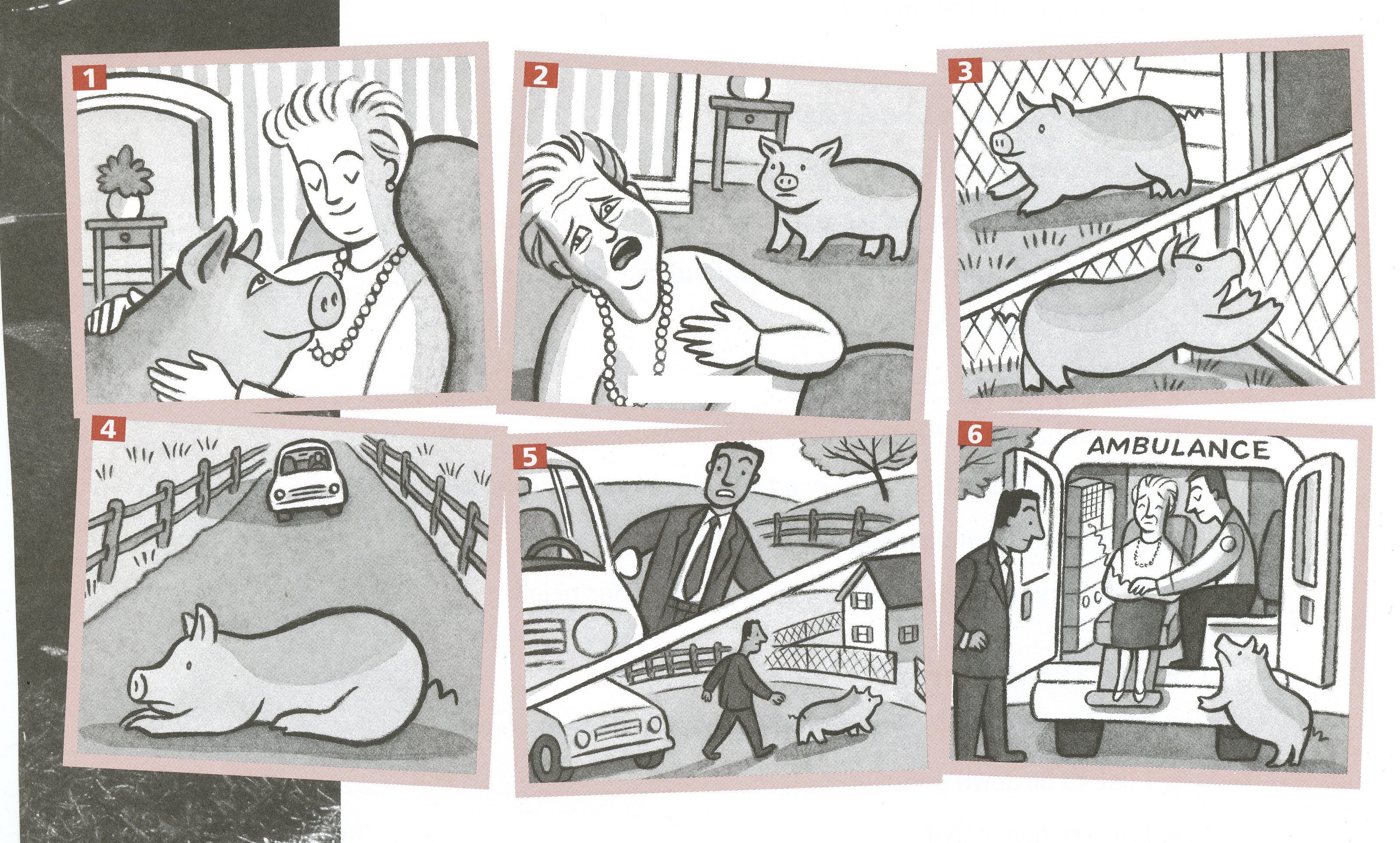…
To the teacher: I took the idea for this lesson from an ESL workbook that I used many years ago. Nothing remains of the book, but for this picture, which I now use as a prompt to get students to write a story together. My lesson is very different from the lesson that was in the workbook originally so there is no plagiarism here—all I can do is thank those forgotten authors from long ago. All good lessons get borrowed and become the lessons of others.
…
Objective:
By working together students will write a story after making a list of words that they will need to write it.
Method:
Teacher talk and discussion
Groups of three, individuals
Materials:
Bilingual dictionaries
Newsprint and markers
Blue painter’s tape
Level:
High beginner to low intermediate
but a good teacher can make a lesson
accommodate any student level
PDF File: Picture Prompts and Correction Marks:
Pig Story, Picture Prompts and Correction Marks
…
Progression:
…
1

Looking and discussing. Place students in groups of three and hand out the pictures. Tell them that they are going to make a list of all the words they see when they look at the six pictures. They may use bi-lingual dictionaries to find the words they know in their own languages, but not in English. Tell them they are going to make a list of all the nouns, adjectives, adverbs, and verbs that they see, especially the verbs. What’s happening?
…
2


Making a list and discussing the words listed. Students may write their lists on newsprint or on the board. When the lists are finished, hang them up on the wall in different parts of the classroom. Now, the students in their groups should get up and go from newsprint to newsprint examining the words. Some students like to stay seated, but get them up and interacting. Everybody looks at all the words generated. Most words, of course, will be similar, but some will not. Focus on the differences, the spelling, and what part of speech each word is.
Note: for hanging up newsprint, by the way, I like to use blue painter’s tape because it doesn’t leave marks on the wall when the lesson is over and the newsprint is taken down.
…
3



Writing a story. Using their new vocabulary, each group will write a story creating it together. Tell them to choose one tense to write in, either the simple past or the simple present. There can be one designated writer, or students can take turns writing, but all the students in the group must add words and ideas to the story. The teacher circulates to make sure that this is happening. All hands on deck!
…
4

Reading and correcting the story. As each group finishes, the teacher can take the newsprint and hang it up. But before the groups get up to read the stories, the teacher should familiarize them with correction marks first because the students are going to need to know how to use them so that they can edit and rewrite later. I have provided a list of correction marks below that my students have used successfully.
Once the students have reviewed the correction marks, let them get up in their groups and look over every story. Give each group a marker to make their own corrections. When finished, every story should have correction marks from every group. The teacher, after the students have corrected, goes over every story one more time to point out any correction errors and make any final corrections.
…
Correction Marks

…

To the teacher: I did the corrections in the story above. It was the first time the class worked together, so I modeled the correcting. Honestly, any correction mark, even a simple check, will do as long as it designates the spot where an error has occurred: knowing where the mistake is is what is important.
Using more specific correction marks allows teachers to indicate mistakes without correcting the work themselves. Letting students know what kind of correction is needed, alerts them to the kind of mistake they have made so they can more easily narrow in on what they need to do to correct it.
There can be several drafts where teacher and student work together toward a perfect paper, but on each draft the teacher indicates where the correction is needed and the student makes the correct correction. The teacher should never rewrite the student’s paper. The student must do that.
…
Results
When students work in groups, they get to know each other better and that is dynamic for a class. And, after working together students are much more able to work alone. The skills students observe in others become their own.
…

Hi Don. I love this lesson! Do you have the picture prompts available?
I have added a downloadable PDF file.
Thank you, Don. I’m going to download the pictures when I get to school!
Please let me know if it works.
Wow, that’s absolutely amazing, I’ll do it when i start teaching
Quite sure it’s an effective method. Please, where can I get more
Thanks for sharing this amazing post. It will be helpful to my daughter to read your article
Genuine advice. Really helpful.
Thanks for sharing that Don. Do you happen to know the name of that old book which you took the set of illustrations from? Many thanks for any help you can give.
Eamonn
I think it might come from a series, Very True Stories, but I only have the picture, not the book.
Creative and helpful guide for storytelling with picture prompts!